| |
|
|
| |
EDITOR'S MESSAGE:
War-Stories continues to receive requests from around the world for permission to link to stories and photos posted at this web site. Most recently, Australia, England, Singapore National Archives, Canada, Vietnam, and China. Generally, requests form Vietnam and China are denied, considering I have no idea what their context is or how they would portray our stories and photos.
In the USA, High Schools, Universities, and Colleges continue referring students to War-Stories.com for research and first-hand accounts of the war.
|
|
| |
|
|
| |
Don Poss
|
|
| |
|
|
| |
Letters to the Editor /
Emails: |
|
|
|
| |
| Book Review & Video Preview: |
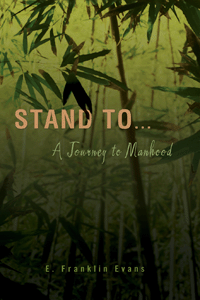 Stand To: A Journey to Manhood Stand To: A Journey to Manhood
by E. Franklin Evans
A Book Review by Don Poss

Vietnam, August 1966 - From the first page of chapter one, Vietnam's impact on American families, one death at a time, is evident: "Noooooooooo. They've Killlllled himmmm!" is a wake up call the nightly Five O'clock Follies war news is all too real.
Raised in the shadows of the World War II generation and weaned on film heroes like John Wayne, Errol Flynn, and Randolph Scott, young war-age men like Evans believed America could never lose a war, being killed in action was out of the question, and those who died did so in glory and in one piece. And yet here it was: Evans' boyhood friend, Glenn, was dead in Vietnam.
A short two years later, Evans had crossed the lines from high school, college student, military enlistment and graduate from Infantry Officer Candidate School. As his aircraft descended into Vietnam, he remembered everything that had brought him to his awaiting destiny.
Thrown as fodder in to the Vietnam jungles, young Army Lieutenant Evans quickly earned his platoon's respect and trust, and the confidence of his superiors. He would need both as they fought along the borders. With bone-weary words blurring into pictures, Evans' recalls to life the memories and wandering shadows of the Vietnam War we all remember: life, death, and dreams revisited. Thundering convoys, air strikes, green tracers--red tracers--and both meant sudden death.
Vietnam borders, phantom Laos-Cambodia choppers, and charred bodies in the wire, all combined to an unnatural fear as you stalked the trail. A wariness crept in to your DNA. Bamboo viper snakes beckoned for a quick two-step ... a short dance with death; elephants packing supplies on the Ho Chi Minh Trail; jungle covered extinct volcanoes; LPs...One Click, Yes...Two No; Choi Hoi good-bad guys; razor sharp elephant grass; LZs, OPs, Montagnards, White Mice, Intell VC Prisoners. Fogged memories piled up and depressed the spirit to bedrock...a MOH medic... NVA bunkers, dust off sky buckets, and never underestimated staff wienies and lifers. And you recognized anew the old truth: Anywhere in a combat zone it was dangerous, and fatal, to let your guard down!
Stand To is more than a war story of misery, pain, and emotions checked at the border. It is a story of survival from enemies and friendlies alike, where both are deadly on this explosive journey to manhood. Just as important, there are glimmers of the humor that keeps combat soldiers sane, including a knife fight with a turkey, and VC chickens, that demonstrate the vitality and nature of American warriors.
Stand To...where forgotten truths are stirred from the dust and a part of your soul remains buried forever. You've lived the memories through the decades ... if not, then you weren't there. Stand To ... A Must Read!
Don Poss
Check out Stand To's VIDEO PREVIEW
Author E. Franklin Evans
is War-Stories Life Member #18
|
Two Featured Stories: |
Gently Down The Stream
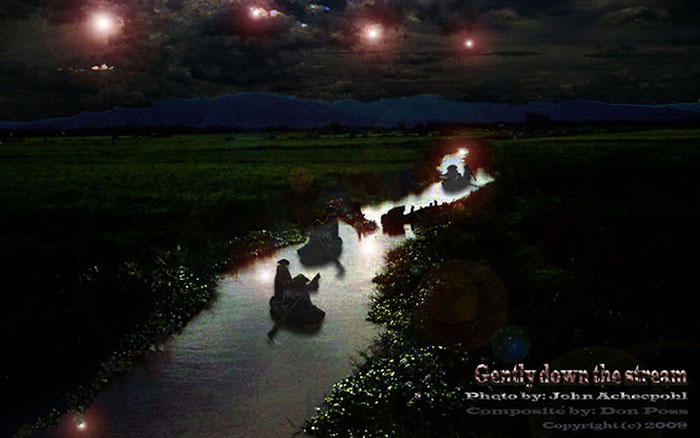
|
John Achecpohl submitted a photo of Phan Rang, common to Vietnam and Thailand, depicting a sight we all may remember: a stream meandering through a meadow, or paddies, with distant mountains…beautiful in daylight, threatening at night, and always burdened with untold mysteries of survival and sudden death. John’s above photo is a composite rendered in to a threatening-night scene so common back then. It was easy for me to visualize drifting sampans … and to feel the adrenalin rush as to whether those riding the gentle current were friends or foe….
Gently Down the Stream …
By: Don Poss
Copyright 2009
Papasan steered the small lead-sampan through the darkness over even darker waters, followed by family in two other small boats. The night was quiet and his mind drifted, fretting over family, as the war could be heard in the distance like the eternal hum of a fertile night.
He had hoped the family gathering would have gone better…a gathering, such as it was, considering what the war had left of his family. Three sons already lost to the war...and two surviving sons fighting on opposite sides. Still… at least we were all together tonight, however briefly, after a frightful night of paddling upstream.
There was no love lost between the brothers, and only duty toward their elder grandfather had compelled them to his side a final time. It pleased the father that both sons actually wanted to be there, and did so against their superior's wishes.
Grandfather had held both their hands as they knelt on either side of his deathbed. And at that moment, his joy soared and he was happy once more…even as his spirit left him. The priest was not happy, having advised against bringing the two brothers together and disrupting the tranquility of the dying process…he had prophesied the fate of the spirit could be harmed during departure from the body. None of that concerned the old man...only his village, family, son and grandsons mattered.
When grandfather’s spirit finally whirled into the night…he could only hope the priest was wrong in his divining of the spirit's fate. Yet, for the briefest moment, it seemed the brothers had forgotten their differences, caring and remembering their childhood and a happy playful grandfather. Then the magic of that moment smoked away, leaving him as the families' elder.
A cloudy moonless night had given hope to a successful trip to and from the neutral meeting-village, and the few miles of paddling and drifting that required. Earlier that morning, he had reluctantly boated his father, priest, and some family to that village, and returned for wife and daughters and a risky night journey. He feared he would lose his two sons as he had their older brothers. He knew there was real danger in even bringing them together, with their nearby hothead young warrior friends ready to pounce. He had arranged to send both sides ample quantities of food, hoping to distract them from war-like thoughts.
Again his mind replayed the earlier evening, when the black clad younger son had fled the hut without parting words. His chilled heart feared they would never meet as a family again, and it struck him that could even be possible should both survive the war. Fear played a daily role in his song of life.
The oldest boy had joined the army and hated his brother with an equaled deadly passion. But at least this night, neither had exchanged harsh words as during their last meeting more than a year ago. Father forced himself to set aside the family pain the night had brought in fulfilling his own father’s last wishes. Now it remained for him to skirt the gauntlet between warring-sides a second time this night, where danger lurked for his family in every direction. His thoughts drifted with the current. At any moment, he knew, the younger boy’s Viet Cong friends could ambush and slay them all in seconds…or his brother’s army comrades could shoot at them with giant rifles requiring several men just to fire it. Or the foreigners could breathe fire from the sky like a dragon…and they were mightier than a dragon. What did such mighty people want with his poor world? They didn’t even need the moon…they had chased away the darkness with fireballs, like Chinese fireworks, and were even now lighting the night sky with many suns, searching for whatever they searched for. Curfew, they had called it…his mind gave name to his transgression. The North had their rules. Saigon had their rules. The foreigners had their rules. No one ever asked him what rules he wanted.
What do I want...really want? he mussed. His thoughts rambled a lifetime...peace from their rules, for his village...to be left alone...his village did not need the rules of foreigner's from Saigon, Hanoi, or the Chinese, Japanese, French, or Americans. In fact, his village needed nothing beyond the life-giving mountains on the horizon. Mostly, he yearned for the Quiet-Times of his father's youth...which few could now remember...and wondered if such times ever really existed.
For now he only wanted to lead his scared and hungry family safely home, and worried if their boats’ flare-light reflections in the mirror like stream could be seen by the iron-bugs of the sky. He glanced back to the trailing sampans. The last boat was like a wisp of smoke as one of his daughters poled it forward. He could not quite make out which daughters steered or poled, but knew his wife would silence their prattling ...mostly about the bright lights of the city and the hovel of the village.
He glanced once more to the dark sky where danger often hovered. He feared those hovering-whirring monsters of the night more than anything, and knew they could easily slay his family, like a fire-tongue from a flying frog.
They drifted onward… gently down the stream … as he thought of his father in happier times, and prayed his spirit would once more find the peace of the Quiet-Times.
|
|
|
| |
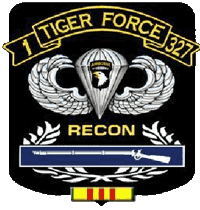 |
Ghost Warriors |
|
by: TJ McGinley
Tiger Force Recon
1/327/101st Abn. Div.
Vietnam 1968-1969
© 2009 |
|
| |
In November of 1968, I was walking slack for 1/327/101st Airborne Divisions recon team “Tiger Force,” in the jungle covered mountains of the Central Highlands, about 50 miles west of Hue, South Vietnam. John Gertsch was walking point that day, when we came across a well-used trail. Gertsch stopped and put his left fist up, which meant that everyone stop and be perfectly quiet. Then he spread his hand out in an open gesture, which meant, quietly, get down and pay attention. We did. Gertsch and I checked the trail for tracks and any another other signs of enemy activity. We found fresh prints and reported back to the lieutenant, who told us to set up an ambush.
Within 15 minutes, a small patrol of six NVA appeared on the trail. We waited until they were in the right spot, made sure there were no more NVA behind them and the opened fire. Afterwards, we cleared the trail, cleaned up any evidence that we were there and left the area. One of the NVA soldiers was an officer and was carrying maps and paperwork. We walked to a suitable site and called in a helicopter to take the NVA paperwork to the rear to be analyzed.
We hiked for another hour and set up a night defensive position. Early in the evening, Gertsch, Zeke, Campos and I, quietly discussed the day’s events before taking our defensive positions. As I sat in silence, just listening to the jungle, I reflected back on just how I got to be in this elite unit of sky solders.
When the United States first started sending significant numbers of troops to Vietnam,
we were using WWII tactics. This didn't work against the North Vietnamese who were waging guerrilla warfare, and it soon became clear that superior firepower and company-sized units were ineffective. A unit of 180 men moving through the jungle could be heard for miles giving the enemy time to react to our presence.
Late in 1965, a young and highly decorated Lt. Col. in the 101st Airborne Division, David Hackworth convinced his superiors we would have a greater success using smaller, well-armed, camouflaged units that could move quietly through the jungle. The first of these small units were created from hand-picked, experienced volunteers from the First Brigade of the 101st. They became known as Tiger Force.
I was the second of nine children, four of which were draft age in 1967. The oldest was in the Marines already, one was in military school and another was about to graduate from high school. I’d just graduated and had no plans for college. Besides, I felt if I went to Vietnam the chances of my brothers going would be slim. It worked, I went and everybody else stayed home.
I arrived in Biên Hòa, Vietnam, on April 4, 1968, and spent a month or so in additional training in the 90th replacement. Afterwards we flew north to Camp Eagle where I spent a single night before I took the first of countless helicopter rides along with a few other new guys and me, “cherries” as we were called, a fire base called Veghel.
I spent one hour there and with the rest of the replacements walked into the jungle to meet my company on a hilltop overlooking the mountains and valleys of the Central Highlands. Little did I know that walking through some of the most difficult and remote terrain in South Vietnam would be what I did for the next fourteen months.
|
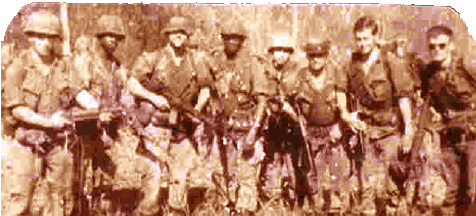
Vietnam was divided into three zones. The northern zone was I Corps which consisted of battle grounds like the DMZ, The Rock Pile, Khe Sanh and the closest supply routes from North Vietnam into the south, the A-Shau Valley.
I Corps was manned by conventional large scale, well armed, well trained and well resupplied NVA Regular Army Divisions.
Farther south, II and III Corps were dominated by enemy units called the Viet Cong that used more of a guerrilla warfare tactic.
Photo: 2 Squad, 2 Platoon, C Co. 1/327/101 1968
|
|
Because I was not married, I was assigned the job of walking point for C Company, 1/327, 101st Airborne Division, a line company with around 120 men. During the month of May 1968, we were operating in an area about fifty miles west of Hue know as the Ruong-Ruong Valley. During a daily patrol, we discovered something that illustrated how determined our enemy really was. We walked into a natural cathedral fashioned by an eighty-foot canopy, covering a 300-yard diameter clearing, and surrounded on three sides by a river.
In the center of this clearing, covered in foliage to camouflage it from the air sat one of the largest caches of enemy weapons ever found during the Vietnam War--five Chinese 85- Howitzers, several crew-serviced anti-aircraft guns, hundreds of rifles, mortars, anti-tank weapons and in the surrounding jungle, 58 Russian trucks full of equipment. Looking at a topographical map we could trace the route the enemy used to transport the weapons from Laos, through the A-Shau Valley and into the Rong-Rong where we found them.
|
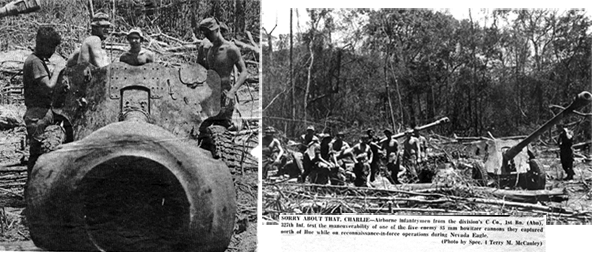 Above Photo: 85 Howitzers in the Roung-Roung Valley 1968
Above Photo: 85 Howitzers in the Roung-Roung Valley 1968 |
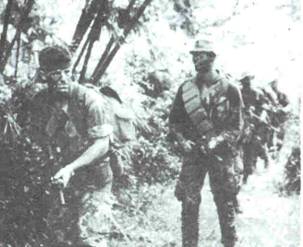 |
Left Photo: Humpin' the trail.
Under normal circumstances we never stayed in one
location longer then one night but with all this enemy
weaponry to protect we were told to do something I
had never done before -- dig in. I wasn’t much of
a
believer in fox holes. I preferred the idea of silence
and camouflage over digging a hole. My excavation
was six feet long, four feet wide, and two feet deep.
I felt now that they know exactly where I am, this hole,
regardless of how deep I could dig it, would do me no
good.
On our second day at this site, we heard that a
friendly
|
unit would penetrate the perimeter at our sector. From out of the jungle came the most impressive unit of soldiers I had seen to date, Tiger Force. Clad in French camouflage fatigues, carrying sawed off shotguns and AK47s, and not one man wore a helmet, these men had a look of people who meant business. I had waked point long enough to know that a helmet was a decrement to one’s ability to hear, I never wore one.
Tiger Force camped with us that night and their quiet confidence and obvious field experience drew me like a magnet. I knew at that moment, that if I were going to spend the next several months in the jungle, I wanted to be with people who knew what they were doing and this unit of about thirty men had that effect on me. In the morning I discovered that the Tigers had vanished silently into the jungle while we slept.
C, Company stayed at the sight until all the weapons had been either removed or destroyed. Afterwards we continued our mission and headed west toward Laos. When we reached the boarder we turned north. The NVA used The A-Shua Valley as a major supply route to funnel weapons and supplies, such as we found in the Ruong-Ruong Valley. At certain times during the year, the rains prevented Americans from moving into this valley. The enemy used this time and weather to their advantage. Our objective was to protect a corps of engineers who were planting a minefield across the western entrance to the valley off the Ho Chi Min trail from Laos.
On The first of June 1968, we were on a mountain overlooking Laos to our west and the A Shau to the east. That afternoon we witnessed the single most spectacular display of fire power I had ever seen. We watched a B-52 strike down the center on the valley. We could not hear the plains nor do the bombs whistle as they fall but the explosions were an amazing spectral to watch. We where about 10 miles away and we felt the percussion and heard shrap-medal fling through the trees above us. Those who were not lying on the ground suddenly became part of it. The blasts threw trees and debris hundreds of feet into the air as no time elapsed between detonations.
|
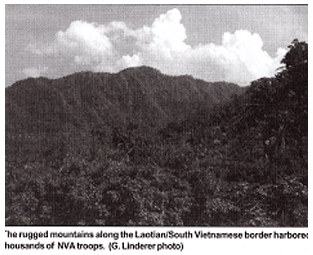 Our commander was Tom Kinane, who had an uncanny ability to look at a topographical map and know where the enemy would be, told us that getting past the fortifications around the valley would be the most dangerous part of our mission. He was right. On several of the high ridges were semi-permanent NVA complexes both above and below ground. It was between two of these fortifications that my squad was ambushed while on patrol. Within two minutes, nine of the eleven men on patrol were wounded. Only the man at the rear of the column and myself were not wounded. Our commander was Tom Kinane, who had an uncanny ability to look at a topographical map and know where the enemy would be, told us that getting past the fortifications around the valley would be the most dangerous part of our mission. He was right. On several of the high ridges were semi-permanent NVA complexes both above and below ground. It was between two of these fortifications that my squad was ambushed while on patrol. Within two minutes, nine of the eleven men on patrol were wounded. Only the man at the rear of the column and myself were not wounded.
All the enemy had to do to stop the advance of the Americans was to wound a few of us and everything would grind to a halt. A hole would be cut in the jungle to accommodate the medevac helicopters. This gave the NVA time to regroup and better prepare for the advancing Americans.
By the morning of June 3rd, we had worked our way to a point high on a ridge facing north. To the west was the Laotian border, to the east was the wide, open terrain of the valley floor and ahead to the north on the other side of the entrance to the valley was a large mountain. The U.S. military identified it was Hill 937, the Vietnamese called it Dong Ap Bai, and a year later Senator Ted Kennedy named it “Hamburger Hill”.
We assented from the south down the mountain and on to the floor of the A-Shua Valley.
This is where our objective changed from exploring jungle covered mountains; mostly never set foot in by humans before us, to protecting a unit of engineers on one of the most heavily used infiltration routes by the North Vietnamese to bring supplies into the south. The engineer’s task was to lay a mine-field across the northern entrance to the valley.
The valley floor consisted of 8ft. elephant grass but no dense jungle or cover, so it was imperative that this operation be finish as quickly as possible.
Orders came around for 1/327 to find out if there was any enemy activity on Hill 937. D Company led the way followed by C Company in support. Once on the valley floor, our personal security evaporated. For the first time in months, large groups of men were totally exposed no canopy no jungle, no place to hide in this enemy stronghold.
Finally, we reached the other side of the valley and started our ascent. Then D Company started receiving fire from somewhere in front of us. We encountered reinforced bunkers, heavy machine gun and mortar fire from what seemed like every direction, way more fire power than we’d encountered to date. Our orders were to find out if there was enemy activity up there, not to take the hill. As soon as we confirmed the hill was occupied, we left. We returned to our sanctuary on the other side of the valley floor where we called in the Air Force to deal with the mountain stronghold. By the time we returned, the entire battalion was on the valley floor protecting the engineers.
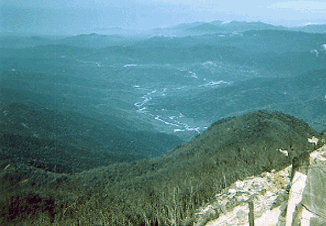 Left Photo: The A-Shau Valley 1968. Left Photo: The A-Shau Valley 1968.
For the next three hours, jets dropped napalm; 250-pound bombs and what seemed like everything but nukes on this hill with anti-aircraft and green tracers being returned by the NVA. Never have I seen such bold action taken by the enemy as I did that day. This hill was different from all the mountains we had explored so far because of its strategic location, guarding the Laotian border and the entrance to the valley. To our north and south-west were mountains. To our west the Laotian border and we were standing in the middle of the Ho-Chi-Minh Trail.
Time was crucial and we knew we were being watched from the surrounding mountains. As night was descending the engineers finished their job. As we were preparing to move out we started receiving incoming mortar rounds from the mountains around us then artillery fire from somewhere in Laos. We had to move and the only direction that was open to us was south, straight down the center of the valley.
Our commander was Tom Kinane, who had an uncanny ability to look at a topographical map and know where the enemy would be, told us that getting past the fortifications around the valley would be the most dangerous part of our mission. He was right. On several of the high ridges were semi-permanent NVA complexes both above and below ground. It was between two of these fortifications that my squad was ambushed while on patrol. Within two minutes, nine of the eleven men on patrol were wounded. Only the man at the rear of the column and myself were not wounded.
All the enemy had to do to stop the advance of the Americans was to wound a few of us and everything would grind to a halt. A hole would be cut in the jungle to accommodate the medevac helicopters. This gave the NVA time to regroup and better prepare for the advancing Americans.
By the morning of June 3rd, we had worked our way to a point high on a ridge facing north. To the west was the Laotian border, to the east was the wide, open terrain of the valley floor and ahead to the north on the other side of the entrance to the valley was a large mountain. The U.S. military identified it was Hill 937, the Vietnamese called it Dong Ap Bai, and a year later Senator Ted Kennedy named it “Hamburger Hill”.
We assented from the south down the mountain and on to the floor of the A-Shua Valley.
This is where our objective changed from exploring jungle covered mountains; mostly never set foot in by humans before us, to protecting a unit of engineers on one of the most heavily used infiltration routes by the North Vietnamese to bring supplies into the south. The engineer’s task was to lay a mine-field across the northern entrance to the valley.
The valley floor consisted of 8ft. elephant grass but no dense jungle or cover, so it was imperative that this operation be finish as quickly as possible.
Orders came around for 1/327 to find out if there was any enemy activity on Hill 937. D Company led the way followed by C Company in support. Once on the valley floor, our personal security evaporated. For the first time in months, large groups of men were totally exposed no canopy no jungle, no place to hide in this enemy stronghold.
Finally, we reached the other side of the valley and started our ascent. Then D Company started receiving fire from somewhere in front of us. We encountered reinforced bunkers, heavy machine gun and mortar fire from what seemed like every direction, way more fire power than we’d encountered to date. Our orders were to find out if there was enemy activity up there, not to take the hill. As soon as we confirmed the hill was occupied, we left. We returned to our sanctuary on the other side of the valley floor where we called in the Air Force to deal with the mountain stronghold. By the time we returned, the entire battalion was on the valley floor protecting the engineers.
For the next three hours, jets dropped napalm; 250-pound bombs and what seemed like everything but nukes on this hill with anti-aircraft and green tracers being returned by the NVA. Never have I seen such bold action taken by the enemy as I did that day. This hill was different from all the mountains we had explored so far because of its strategic location, guarding the Laotian border and the entrance to the valley. To our north and south-west were mountains. To our west the Laotian border and we were standing in the middle of the Ho-Chi-Minh Trail.
Time was crucial and we knew we were being watched from the surrounding mountains. As night was descending the engineers finished their job. As we were preparing to move out we started receiving incoming mortar rounds from the mountains around us then artillery fire from somewhere in Laos. We had to move and the only direction that was open to us was south, straight down the center of the valley.
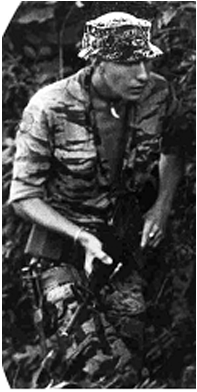 Left Photo: TJ McGinley. Left Photo: TJ McGinley.
It was my turn to walk point. Without delay we took off and not at a slow pace. It was getting dark, fast and moving through the elephant grass even though we were being cut to ribbons by the razor sharp blade of this type of vegetation, we could move much quicker than in the dense jungle. After about an hour we slowed down realizing where we were as we came across crumpled barbed wire and rotten sand bags. I knew we had found the abandoned Green Beret camp that was overrun by the NVA in 1966. This put me in my place and I realized what I was doing and where I was, walking point through one of the most dangerous locations on the planet in 1968, the A-Shau Valley in the middle of the night.
I encountered two separate groups of NVA soldiers during our march. Americans never moved at night, so our adversaries didn’t know just what to do when I appeared out of the vegetation, so they ran. Not wanting to broadcast our location. We didn’t give chase or expel too many rounds at the fleeing enemy. I didn’t know the size of the force we had encountered and they didn’t know how many of us there were. It was kind of an instantaneous mutual understanding among adversaries in this very odd situation, to leave well enough alone. Firefights raged all through the valley as encamped units of Americans were being probed by the NVA.
We slowed our pace now that we were out of range of the artillery that was pursuing us. After what seemed like weeks the most beautiful dawn that I can remember started to unfold. We had radioed ahead to an American unit to be expecting our approach from the north. What they saw must have resembled a scene from a Steven King novel. From out of the early morning mist came a unit of ghost soldiers. The elephant grass, which we mostly ignored, had cut us to shreds. We were completely out of food, low on ammo, water, and strength. We had been up for 48 hours and the last eight we had walked, at night, through ten miles of one of the most enemy infested location in all of South Vietnam.
Later that day the First Brigade of the 101st was extracted from the A-Shau Valley after being in the jungle of the Central Highland for more than three months.
During the five day stand-down at Camp Eagle, several members of C, Company including myself, decided to join Tiger Force. It was in this elite group of paratroopers that I first met men who could “out-Indian” the Indians. This recon team consisted of about 30 well-seasoned, handpicked volunteers.
|
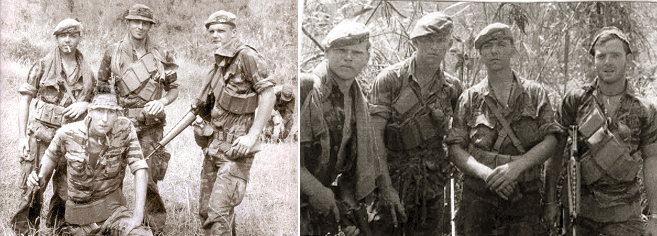
Left Photo: Zeke Blevins, John Toberman, Dave Fields and TJ McGinley.
Right Photo: Sparks, Rader Rick, Zeke Blevins, and Stan Parker |
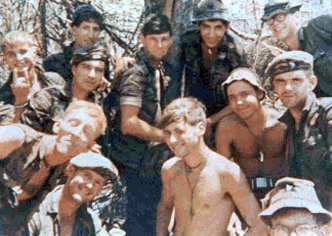
Left Photo: Tiger Force, July1968.
Under the command of Lt. Fred Raymond, John Gertsch, Dave Fields, and others, Tiger Force worked with a smoothness and efficiency that even surprised the enemy.
Tigers ran recon for the First Brigade and would be the unit called on if one of the line companies was in trouble or needed help. But our specialty was ambush and recon.
Gertsch, as he was known, was a master in the field, teaching all who were near the ways of the jungle and how to use it to their advantage. In his words, “how to really be there, but not be there.” When there was any kind of fighting going on, you could find John diving into it doing what had to be done to get his fellow paratroopers out of danger with no thought for his own safety.
One day we were hit and pinned down by a well-planned NVA ambush. Gertsch was on point. Instead of pulling back, John crawled forward alone. The NVA didn’t see him until he came up in the middle of their perimeter. Before we knew what happened, Gertsch had killed most of most them and returned with three prisoners.
|
Another time John led Tigers on a two day hunt through the A-Shau Valley chasing a PT-76 NVA tank. Nobody stopped to ask what we’d do if we caught up with it. The tank made it back across the Laosion border before we caught it. Gertsch stomped where angles, or devils feared to tread.
Tiger Force had seen more action then any other unit in the Division. And Jonh was the best of the best. Any man who’s been hit twice by claymores and still walks point has more nerve then any one man deserved.
John was ending his third consecutive tour with Tigers when he was chosen to represent the 101st Airborne Division at an annual reunion to be honored as soldier of the year in Ft. Campbell. John knew Tiger Force was headed back into the notorious A-Sau Valley and his experience was needed for this dangerous mission. He decided to stay with his unit and help out. As it turned out that decision was very costly for all of us.
Tiger Force was choppered into the A-Shau Valley on July17, 1969 and two days later they were ambushed. The platoon leader was seriously wounded and it was Gertsch who dragged him to a sheltered position. John assumed command of the heavily engaged platoon and led his men in a fierce counterattack that forced the enemy to withdraw and recovered two wounded comrades.
A short time later, Tigers were attacked again. John charged forward firing as he advanced. Together, John and the other Tigers forced the enemy to withdraw.
Sometime later his platoon came under attack for the third time by a company sized NVA element. John was severely wounded during the onslaught. During the attack, he noticed a medic treating a wounded officer. Realizing that both men were in imminent danger of being killed, John rushed forward and positioned himself between them and the enemy. While the wounded officer was being moved to safety, John was mortally wounded.
|
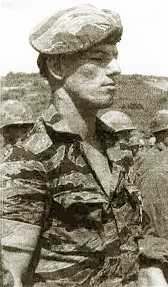 Left Photo: John Gertsch, July1968. Left Photo: John Gertsch, July1968.
By the end of the Vietnam conflict Tiger Force had seen more combat than any other unit in the Brigade and become one of the highest decorated units of its size in the military at the time. Sixty percent of its members had awarded the Bronze Star for valor, thirty percent Silver Stars, and two Tigers received The Congressional Medal of Honor.
Lt. James Gardner, CO of Tiger Force KIA Feb. 7, 1966, was awarded a Purple Heart, three Bronze Stars, two Silver Stars and The Congressional Medal of Honor.
My mentor and good friend John Gertsch was KIA in the A-Shau on June 19, 1969.In all John was awarded three Purple Hearts, three Bronze Stars with V, five Silver Stars, and for his actions on July 19, John was awarded The Congressional Medal of Honor.
Our commander and founder, Col. David Hackworth died at his home on May 14, 2007.
David was involved in every conflict the U.S. was in from WWII through Vietnam. David was awarded eight Purple Hearts, eight Bronze Stars, ten Silver Stars, and two Distinguished Service Crosses and was put in for The Congressional Medal of Honor three times.
|
| |
Fred Raymond is still in the military. He works for the Department of Veterans Affairs and holds the rank of Major General. Fred still has the respect of all who had the honor of serving under him.
Being a member of this elite unit of Ghost Worriers was the pinnacle of my brief time in the military.
TJ McGinley
Tiger Force Recon
1/327/101st Abn. Div.
Vietnam '68-'69
|
|
Author TJ McGinely
is an active member of War-Stories
|
| |
|
|
| |
|
|


 Stand To: A Journey to Manhood
Stand To: A Journey to Manhood




 Our commander was Tom Kinane, who had an uncanny ability to look at a topographical map and know where the enemy would be, told us that getting past the fortifications around the valley would be the most dangerous part of our mission. He was right. On several of the high ridges were semi-permanent NVA complexes both above and below ground. It was between two of these fortifications that my squad was ambushed while on patrol. Within two minutes, nine of the eleven men on patrol were wounded. Only the man at the rear of the column and myself were not wounded.
Our commander was Tom Kinane, who had an uncanny ability to look at a topographical map and know where the enemy would be, told us that getting past the fortifications around the valley would be the most dangerous part of our mission. He was right. On several of the high ridges were semi-permanent NVA complexes both above and below ground. It was between two of these fortifications that my squad was ambushed while on patrol. Within two minutes, nine of the eleven men on patrol were wounded. Only the man at the rear of the column and myself were not wounded.  Left Photo: The A-Shau Valley 1968.
Left Photo: The A-Shau Valley 1968. Left Photo: TJ McGinley.
Left Photo: TJ McGinley.

 Left Photo: John Gertsch, July1968.
Left Photo: John Gertsch, July1968.